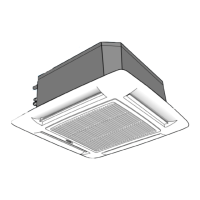START-UP
Preliminary Checks
1. Make sure all wiring connections are correct and they are
tight.
2. Field electrical power source must agree with unit name
plate rating.
3. Check that all barriers, covers, and panels are in place. En-
sure that the filters and return-air grilles on the indoor unit
have been installed and that the discharge louvers are posi-
tioned correctly.
4. All service valves must be closed.
5. On units with crankcase heaters, ensure belly-band heaters
are tight around the compressor.
Evacuate and Dehydrate the System
[]NIT DAMAGE HAZARD
Failure to follow this caution may result in equipment damage
or improper operation.
Never use the system compressor as a vacuum pump.
Refrigerant tubes and indoor coil should be evacuated using the
recommended deep vacuum method of 500 nficrons, the alternate
triple evacuation method may be used if the procedure outlined
below is followed. Always break a vacuum with dry nitrogen.
[]sing Vacuum Pump
1. Completely tighten flare nuts A, B, C, D, connect manifold
gage charge hose to a charge port of the low side service
valve. (See Fig. 40.)
2. Connect charge hose to vacuum pump.
3. Fully open the low side of manifold gage. (See Fig. 41)
4. Start vacuum pump
5. Evacuate using either deep vacuum or triple evacuation
method.
6. After evacuation is complete, fully close the low side of
manifold gage and stop operation of vacuum pump.
7. The factory charge contained in the outdoor unit is good for
up to 25 ft. (8 m) of line length. For refrigerant lines longer
than 25 ft (8 m), add 0.3 oz. per foot of extra piping up to
the maximum allowable length.
8. Disconnect charge hose from charge connection of the low
side service valve.
9. Fully open service valves B and A.
10. Securely tighten caps of service valves.
Outdoor Unit Refrigerant
_B Low Side
High Side
Service Valve
Indoor Unit
A07360
Fig. 40 - Service Valve
Manifold Gage
500 microns _
low side valve
..-',"_ L_ High side valve
Charge hose--_ _,d Charge hose
[_4 __//Vacuum pump
//
\
Low side valve
Fig. 41 - Manifold
A07361
Deep Vacuum Method
The deep vacuum method requires a vacuum pump capable of
pulling a vacuum of 500 nficrons and a vacuum gage capable of
accurately measuring this vacuum depth. The deep vacuum method
is the most
liquid water.
if)
Z
O
iv-
O
m
_ositive way of assuring a system is free of air and
See Fig. 42)
LEAK IN
SYSTEM
.VACUUM TIGHT
TOO WET
TIGHT
DRY SYSTEM
1 2 3 4 5 6 7
MINUTES
Fig. 42 - Deep Vacuum Graph
A95424
Triple Evacuation Method
The triple evacuation method should only be used when vacuum
pump is only capable of pumping down to 28 in. of mercury
vacuum and system does not contain any liquid water.
Refer to Fig. 43 and proceed as follows:
1. Pump system down to 28 in. of mercury and allow pump to
continue operating for an additional 15 nfinutes.
2. Close service valves and shut off vacuum pump.
3. Connect a nitrogen cylinder and regulator to system and
open until system pressure is 2 psig.
4. Close service valve and allow system to stand for 1 hr. Dur-
ing this time, dry nitrogen will be aMe to diffuse throughout
the system absorbing moisture.
5. Repeat this procedure as indicated in Fig. 43. System will
then be free of any contanfinants and water vapor.
24

